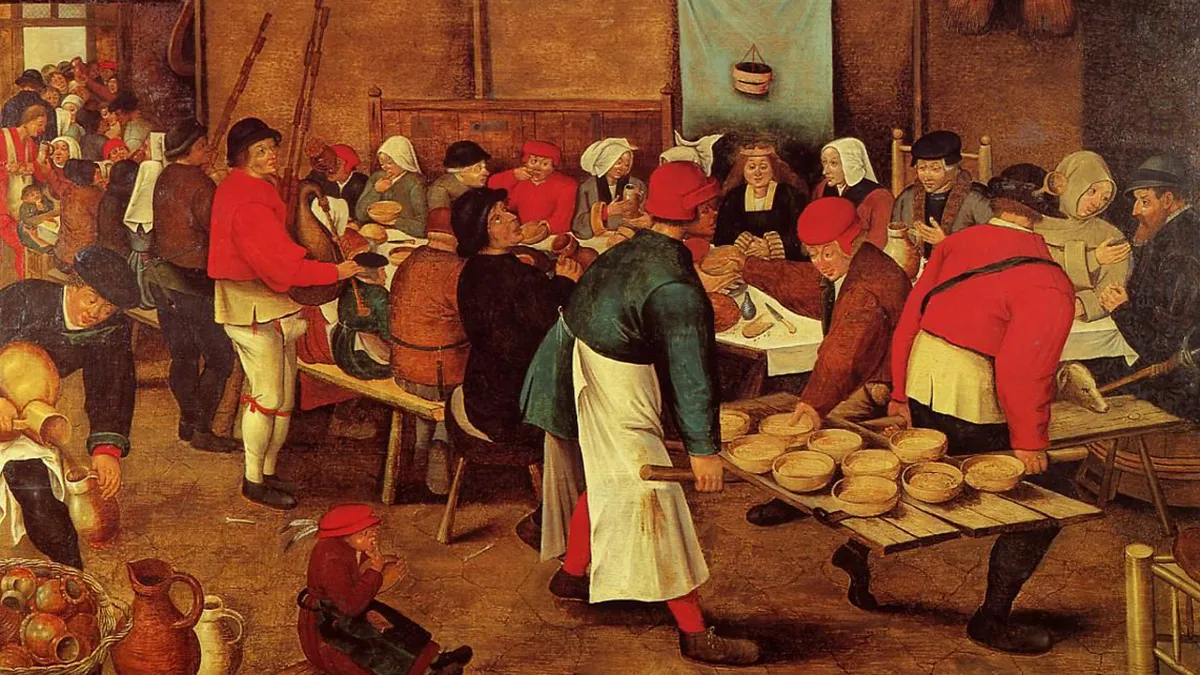Table of Contents
New diet fads sweep the Western world about as often as a dieter sneaking off to the fridge. The Israeli Soldier Diet, the Atkins Diet, the Paleo Diet, blah, blah, blah. Perhaps the next diet fad will be the Mediaeval Peasant Diet.
But, unless it’s accompanied by the Mediaeval Peasant Workout, participants can expect to bulk up quicker than Eric Cartman chugging down a crate of Weight Gain 4000.
It all starts with breakfast – or, rather, skipping it.
It was believed that eating too early in the day was a form of committing the sin of gluttony. This nugget of wisdom came from the famous intellectual priest Thomas Aquinas.
Nowadays we’re told that breakfast is the most important meal of the day, but in the past it was only eaten by laborers and greedy people! Laborers might eat a small chunk of bread in the morning so they didn’t pass out in the fields.
Breakfast was also given to infants, the sick and the elderly, to build and maintain their strength. But, even if workers didn’t eat as soon as they work, they generally had “fast breaks” of “nuncheons” (snacks, essentially) through the morning, before a larger midday meal. The evening meal tended to be the biggest of all.
But what did they eat?
Bread and grains were a major part of the medieval diet. In fact, it’s estimate that they ate 2-3 pounds (1-1.5 kg) of bread each day! That’s more than an entire loaf of sliced bread.
Common grains such as rye, oats and barley would be made into porridge, and they also drank a lot of low-alcohol ale made from barley.
Ale and beer were drunk in large quantities not least because they were safer than water. Although the germ theory of disease was a thousand years or so in the future, boiling water and barley to make the wort for ale inadvertently sterilised pathogens.
It’s estimated that the amount of rye bread eaten by one person on average was around 3,000 calories. Add to that an additional 1,500 calories worth of ale!
Vegetables and fruits were also consumed – but almost always cooked.
One of the strange beliefs circulating in medieval Europe was that raw fruits and vegetables were dangerous. It was believed that they carried diseases and could make you very sick.
For this reason, all vegetables, and even fruits, would be cooked in some way before consumption.
Even vegetables that we regard as strictly salads, like lettuce, were cooked. Again, this made sense in an era when all produce was ‘organic’ – invariably meaning ‘fertilised with poo’. As has happened even in modern times with ‘organic’ produce, deadly pathogens like E. Coli could lurk on seemingly innocent fruits and vegetables.
Meat was generally beyond the means of peasants, except for what they could scrounge from the landscape. Including hedgehogs and seagulls.
When they could, though, the wealthy pigged out on astonishing amounts of meat.
It was recorded that Archbishop Neville of York had an enormous feast in 1467. The guests consumed “104 oxen, 6 wild bulls, 1,000 sheep, 304 calves, 400 swans, 2,000 geese, 1,000 capons, 2,000 pigs, 104 peacocks, over 13,500 other birds, 500 stags, bucks and roes, 1,500 venison pies, 608 pikes and breams, 12 porpoises and seals” […]
Roasting a whole pig on a spit was a common practice in medieval times, but it was definitely a treat! The most luxurious kind was the suckling pig, ie a baby pig that is still nursing.
Strangely, the baby pig was considered the greatest delicacy. The nursing mother was also appreciated, and even the “sow’s womb” was a gourmet treat.
The most important source of protein for peasants was likely the humble bean.
Considering that the average worker couldn’t afford to eat much meat, the cultivation of legumes was a game changer. Italian medievalist Umberto Eco argues that the widespread introduction of beans into the medieval diet is responsible for the survival of Western civilization during the Middle Ages!
Prior to this point in history, the average person was unable to find sufficient protein for a healthy diet. Beans were a heart-healthy and easily accessible protein source.
Eco theorizes that the introduction of beans helped build a strong and healthier population, capable of working properly in the fields, producing more children and living longer lives.
There was even fast food and vegan food.
Popular snacks like meat pasties, hotcakes, pancakes and wafers would be prepared in advance and sold for quick consumption.
The types of establishments that sold fast food weren’t considered to be very reputable. They were generally thought to be dirty and dishonest, using bad meat and trying to pass off beef for venison […]
The Catholic Church decreed that meat and other animal products could not be consumed on days of fasting. As an alternative, chefs would make a milk out of almonds or walnuts that could be used instead of cows milk.
The Mediaeval diet was, like most pre-modern diets, very low on refined sugar. Sweet dishes of any kind were generally beyond the means of peasants, but what passed for the middle classes and the nobility did enjoy their desserts – though not always at the end of a meal as we do today.
Feasts would usually include many different courses, and, surprisingly, the desserts weren’t just served at the end.
Several different desserts would be dispersed throughout the feast in between the savory dishes. It was thought that this cleansed the palate. Common desserts included pies and marzipan.
Stars Insider
Still, mediaeval peasants weren’t generally noted for obesity, even despite their high-calorie, high-carb diet.
That’s where the Mediaeval Peasant Workout came in. Although peasants got to slack off during winter, during summer, 12-hour days of hard labouring in the fields were commonplace. Autumn harvest was also a pretty intense workout, as was spring sowing.









